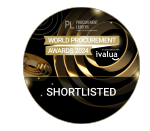Risk, Resilience, and how
Technology is changing the game
JULY 2024
Recent disruptions have put a spotlight
on risk for many organizations.
How can you best address it?
In 2023, leading industry research showed that more than 70% of CPOs indicated supply chain-related disruptions have increased from an already elevated baseline from the year prior. Inflation, supply shortages, and ESG were cited as major areas of concern. While organizations have been dealing with risk for decades, the recent turbulence has put it firmly at the forefront for many C-suite decision-makers.
As today’s organizations weigh the benefits and trade-offs of risk, they are likewise seeking greater resilience, which, by definition, means understanding the inherent trade-offs with risk. The most recent edition of the PWC CEO survey highlights a marked increase in CEOs eyeing more transformative change, reinventing and rewiring in response to concerns about the long-term viability of current business models. Building resilience is cited as a key driver by 39%, with growth strategy leading at 78%. (Maybe pop out/highlight this last sentence) Arguably, however, the two interlink; supply chain resilience will be a pivotal enabler of a successful growth strategy.
Unsurprisingly, technology is changing the game for how organizations can address risk. Our latest CPO Briefing, looks at the broad impacts and also breaks down how and where this is happening. There may not be one single, holistic solution available to everyone, but there is a broad landscape of technology being used to enable different distinct parts of supplier and supply chain risk programs.


So how exactly does technology enable risk management?
Typically, it allows us to collect and process data, automate tasks and processes, and quite simply operate at a scale and complexity that is impractical for humans and spreadsheets to match.
When it comes to risk management programs, in simple terms businesses most often want to make basic checks on a broad number of suppliers and undertake incrementally more risk activities with a diminishing number of more strategic, and or ‘risky’ suppliers.
10 Pillars for Identifying RisK
To start with, and to lay the foundations for a successful risk program, you must undertake three key activities:
1) identify the risks that your business may be facing;
2) establish your organizational risk appetite and how it wishes to balance these risks with reward; and
3) segment your suppliers based on their risk profile to identify appropriate action
Our report views risk through 10 primary pillars:









